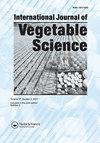Utilizing Ogura-CMS and doubled haploid lines of cabbage for new-generation hybrid breeding
IF 1.1
Q2 Agricultural and Biological Sciences
引用次数: 0
Abstract
In this study, we report the development of a uniform hybrid of cabbage by utilizing cytoplasmic male sterile (CMS) and doubled haploid (DH) genotypes. Firstly, 26 cabbage genotypes were subjected to molecular diversity analysis using 52 SSR primers. Most divergent parents representing CMS (6) and DH (5) genotypes were crossed in Line × Tester mating design during the summer of 2018. During winter, 2018-19, all the parents, their 30 F1’s, and one standard check cultivar (Pusa Hybrid-81) were evaluated for different horticultural traits. Based on the mean performance, three lines viz. KTCB-836A, KTCB-5A, KTCB-6A and two testers viz., KTCB-50-1 and KTCB-51-19 were found superior. Hence, these genotypes can be utilized in future cabbage hybrid breeding programs. While among the 30 DH-based hybrids, six cross combinations viz. KTCB-1A × KTCB-50-1 (586.82 q), KTCB-836A × KTCB-51-19 (568.93 q), KTCB-836A × KTCB-51-2 (557.27 q), KTCB-836A × KTCB-50-3 (527.90 q), KTCB-836A × KTCB-51-6 (517.08 q) and KTCB-836A × KTCB-50-1 (513.06 q) were found superior than the Standard check cultivar, Pusa Hybrid-81 (405.93 q). As these hybrids were quite uniform hence, after multilocations testing they can be released for commercial cultivation in India.利用小谷- cms和白菜双单倍体系进行新一代杂交育种
在本研究中,我们报道了利用细胞质雄性不育(CMS)和双单倍体(DH)基因型培育白菜统一杂种。首先,利用52条SSR引物对26个白菜基因型进行分子多样性分析。在2018年夏季进行的Line × Tester配种设计中,大多数代表CMS(6)和DH(5)基因型的分歧亲本进行了杂交。在2018- 2019年冬季,对所有亲本及其30个F1和1个标准对照品种(普沙杂交-81)进行了不同园艺性状的评价。根据平均性能,KTCB-836A、KTCB-5A、KTCB-6A三个品系和KTCB-50-1、KTCB-51-19两个品系表现较优。因此,这些基因型可用于未来的白菜杂交育种计划。其中,KTCB-1A × KTCB-50-1 (586.82 q)、KTCB-836A × KTCB-51-19 (568.93 q)、KTCB-836A × KTCB-51-2 (557.27 q)、KTCB-836A × KTCB-50-3 (527.90 q)、KTCB-836A × KTCB-51-6 (517.08 q)和KTCB-836A × KTCB-50-1 (513.06 q) 6个杂交组合优于标准对照品种Pusa Hybrid-81 (405.93 q)。
本文章由计算机程序翻译,如有差异,请以英文原文为准。
求助全文
约1分钟内获得全文
求助全文
来源期刊

International Journal of Vegetable Science
Agricultural and Biological Sciences-Plant Science
CiteScore
3.10
自引率
0.00%
发文量
30
期刊介绍:
The International Journal of Vegetable Science features innovative articles on all aspects of vegetable production, including growth regulation, pest management, sustainable production, harvesting, handling, storage, shipping, and final consumption. Researchers, practitioners, and academics present current findings on new crops and protected culture as well as traditional crops, examine marketing trends in the commercial vegetable industry, and address vital issues of concern to breeders, production managers, and processors working in all continents where vegetables are grown.
 求助内容:
求助内容: 应助结果提醒方式:
应助结果提醒方式:


